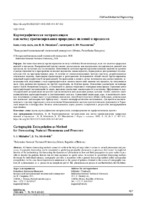| dc.contributor.author | Михайлов, В. И. | |
| dc.contributor.author | Мысливчик, Е. Ю. | |
| dc.coverage.spatial | Минск | ru |
| dc.date.accessioned | 2020-10-02T10:43:57Z | |
| dc.date.available | 2020-10-02T10:43:57Z | |
| dc.date.issued | 2020 | |
| dc.identifier.citation | Михайлов, В. И. Картографическая экстраполяция как метод прогнозирования природных явлений и процессов = Cartographic Extrapolation as Method for Forecasting Natural Phenomena and Processes / В. И. Михайлов, Е. Ю. Мысливчик // Наука и техника. – 2020. – № 5. – С. 407-412. | ru |
| dc.identifier.uri | https://rep.bntu.by/handle/data/79695 | |
| dc.description.abstract | Все известные методы прогнозирования не могут обойтись без помощи карт, если это касается природных явлений и процессов. Географический прогноз можно рассматривать как предсказание географических явлений или процессов, не доступных для исследования. Идентичность методики прогнозирования динамики явлений во времени и распространения их в пространстве позволяет переносить закономерности, справедливые для временных последовательностей, на пространственные ряды. В отличие от специализированных методов прогноза, разрабатываемых отдельными науками, картография предоставляет в распоряжение исследователя общий способ прогнозирования, названный картографической экстраполяцией. Экстраполяция в данном случае понимается как распространение закономерностей, полученных в ходе картографического анализа какого-либо явления или процесса, на неизученную часть этого явления или процесса, на другую территорию, на будущее время. Изложенное рассмотрено на примере карты СВДЗК Республики Беларусь, составленной по данным геофизики и повторных нивелировок. Применяя метод картографической экстраполяции по карте, выделены прогнозные закономерности и ожидания. Эффективность картографической экстраполяции возрастает при комплексном использовании разных методов. Особое значение имеет взаимодействие картографического и дистанционного методов. Совместный анализ карт, аэро- и космических снимков, полученных с разных высот и в различных диапазонах, способствует прогнозу общих глобальных, региональных или локальных закономерностей. Пример тому – геолого-геоморфологические исследования. Для прогноза неотектонического строения территории в зоне сочленения Микашевичского выступа кристаллического фундамента и Туровской депрессии в Белорусском Полесье использовались карты разного содержания и результаты дешифрирования аэроснимков. | ru |
| dc.language.iso | ru | ru |
| dc.publisher | БНТУ | ru |
| dc.title | Картографическая экстраполяция как метод прогнозирования природных явлений и процессов | ru |
| dc.title.alternative | Cartographic Extrapolation as Method for Forecasting Natural Phenomena and Processes | ru |
| dc.type | Article | ru |
| dc.identifier.doi | 10.21122/2227-1031-2020-19-5-407-412 | |
| local.description.annotation | All known forecasting methods cannot do without the help of maps when it comes to natural phenomena and processes. Geographic forecasting can be considered as predicting geographic phenomena or processes that cannot be explored. Identity of the methodology for forecasting the dynamics of phenomena in time and their propagation in space makes it possible to transfer the patterns that are true for time sequences to spatial series. In contrast to specialized forecasting methods developed by individual sciences, cartography provides a researcher with a general forecasting method called cartographic extrapolation. In this case the extrapolation is understood as the spread of patterns obtained in the course of cartographic analysis of a phenomenon or a process to an unexplored part of this phenomenon or process to another territory, for the future. The foregoing is considered on the example of a map of Modern vertical movements of the Earth’s crust in the Republic of Belarus which is compiled according to geophysical data and repeated leveling. Predictive patterns and expectations are highlighted while applying the method of cartographic extrapolation on the map. The efficiency of cartographic extrapolation is increased with the complex use of different methods. The interaction of cartographic and remote methods is of particular importance. Joint analysis of maps, aerial and satellite images obtained from different heights and in different ranges helps to predict general global, regional or local patterns. An example of this is geological and geomorphological research. Maps of different contents and the results of interpretation of aerial photographs have been used to predict the neo-tectonic structure of the territory in the zone of junction of the Mikashevich ledge of the crystalline basement and the Turov depression in the Belarusian Polesie. | ru |

